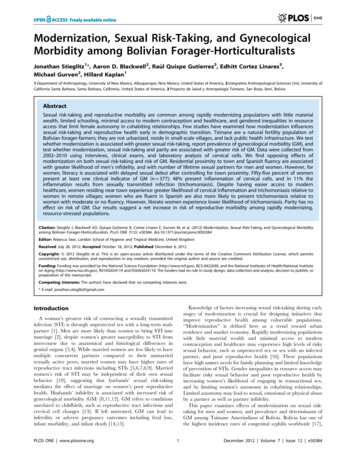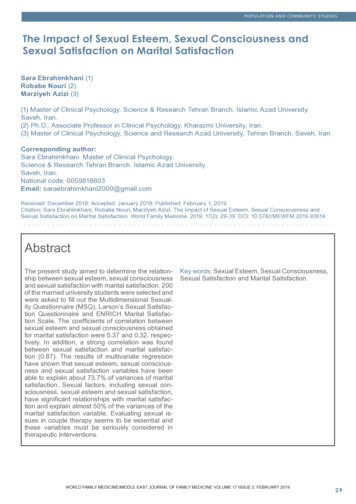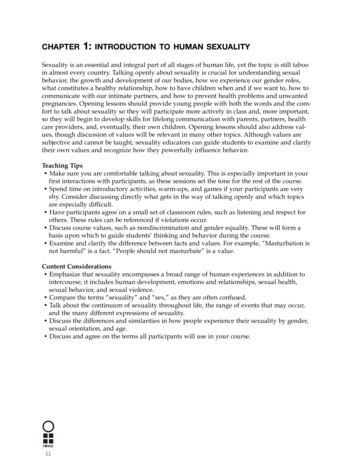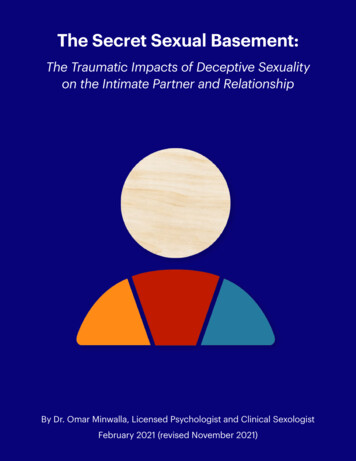
Transcription
Modernization, Sexual Risk-Taking, and GynecologicalMorbidity among Bolivian Forager-HorticulturalistsJonathan Stieglitz1*, Aaron D. Blackwell2, Raúl Quispe Gutierrez3, Edhitt Cortez Linares3,Michael Gurven2, Hillard Kaplan11 Department of Anthropology, University of New Mexico, Albuquerque, New Mexico, United States of America, 2 Integrative Anthropological Sciences Unit, University ofCalifornia Santa Barbara, Santa Barbara, California, United States of America, 3 Proyecto de Salud y Antropologı́a Tsimane, San Borja, Beni, BoliviaAbstractSexual risk-taking and reproductive morbidity are common among rapidly modernizing populations with little materialwealth, limited schooling, minimal access to modern contraception and healthcare, and gendered inequalities in resourceaccess that limit female autonomy in cohabiting relationships. Few studies have examined how modernization influencessexual risk-taking and reproductive health early in demographic transition. Tsimane are a natural fertility population ofBolivian forager-farmers; they are not urbanized, reside in small-scale villages, and lack public health infrastructure. We testwhether modernization is associated with greater sexual risk-taking, report prevalence of gynecological morbidity (GM), andtest whether modernization, sexual risk-taking and parity are associated with greater risk of GM. Data were collected from2002–2010 using interviews, clinical exams, and laboratory analysis of cervical cells. We find opposing effects ofmodernization on both sexual risk-taking and risk of GM. Residential proximity to town and Spanish fluency are associatedwith greater likelihood of men’s infidelity, and with number of lifetime sexual partners for men and women. However, forwomen, literacy is associated with delayed sexual debut after controlling for town proximity. Fifty-five percent of womenpresent at least one clinical indicator of GM (n 377); 48% present inflammation of cervical cells, and in 11% theinflammation results from sexually transmitted infection (trichomoniasis). Despite having easier access to modernhealthcare, women residing near town experience greater likelihood of cervical inflammation and trichomoniasis relative towomen in remote villages; women who are fluent in Spanish are also more likely to present trichomoniasis relative towomen with moderate or no fluency. However, literate women experience lower likelihood of trichomoniasis. Parity has noeffect on risk of GM. Our results suggest a net increase in risk of reproductive morbidity among rapidly modernizing,resource-stressed populations.Citation: Stieglitz J, Blackwell AD, Quispe Gutierrez R, Cortez Linares E, Gurven M, et al. (2012) Modernization, Sexual Risk-Taking, and Gynecological Morbidityamong Bolivian Forager-Horticulturalists. PLoS ONE 7(12): e50384. doi:10.1371/journal.pone.0050384Editor: Rebecca Sear, London School of Hygiene and Tropical Medicine, United KingdomReceived July 28, 2012; Accepted October 18, 2012; Published December 6, 2012Copyright: ß 2012 Stieglitz et al. This is an open-access article distributed under the terms of the Creative Commons Attribution License, which permitsunrestricted use, distribution, and reproduction in any medium, provided the original author and source are credited.Funding: Funding was provided by the National Science Foundation (http://www.nsf.gov), BCS-0422690, and the National Institutes of Health/National Instituteon Aging (http://www.nia.nih.gov), R01AG024119 and R56AG024119. The funders had no role in study design, data collection and analysis, decision to publish, orpreparation of the manuscript.Competing Interests: The authors have declared that no competing interests exist.* E-mail: jonathan.stieglitz@gmail.comKnowledge of factors increasing sexual risk-taking during earlystages of modernization is crucial for designing initiatives thatimprove reproductive health among vulnerable populations.‘‘Modernization’’ is defined here as a trend toward urbanresidence and market economy. Rapidly modernizing populationswith little material wealth and minimal access to moderncontraception and healthcare may experience high levels of riskysexual behavior, such as unprotected sex or sex with an infectedpartner, and poor reproductive health [16]. These populationshave high unmet needs for family planning and limited knowledgeof prevention of STIs. Gender inequalities in resource access mayfacilitate risky sexual behavior and poor reproductive health byincreasing women’s likelihood of engaging in transactional sex,and by limiting women’s autonomy in cohabiting relationships.Limited autonomy may lead to sexual, emotional or physical abuseby a partner as well as partner infidelity.This paper examines effects of modernization on sexual risktaking for men and women, and prevalence and determinants ofGM among Tsimane Amerindians of Bolivia. Bolivia has one ofthe highest incidence rates of congenital syphilis worldwide [17],IntroductionA woman’s greatest risk of contracting a sexually transmittedinfection (STI) is through unprotected sex with a long-term malepartner [1]. Men are more likely than women to bring STI intomarriage [2], despite women’s greater susceptibility to STI fromintercourse due to anatomical and histological differences ingenital organs [3,4]. While married women are less likely to havemultiple concurrent partners compared to their unmarriedsexually active peers, married women may have higher rates ofreproductive tract infections including STIs [5,6,7,8,9]. Marriedwomen’s risk of STI may be independent of their own sexualbehavior [10], suggesting that husbands’ sexual risk-takingmediates the effect of marriage on women’s poor reproductivehealth. Husbands’ infidelity is associated with increased risk ofgynecological morbidity (GM) [8,11,12]. GM refers to conditionsunrelated to childbirth, such as reproductive tract infections andcervical cell changes [13]. If left untreated, GM can lead toinfertility or adverse pregnancy outcomes including fetal loss,infant morbidity, and infant death [14,15].PLOS ONE www.plosone.org1December 2012 Volume 7 Issue 12 e50384
Modernization and Reproductive Behavior and Healthand creating desires for companionship to relieve loneliness[23,24]. Even in developed countries such as the U.S., residencenear urban centers is associated with more permissive attitudestoward extra-marital sex [25].For women, modernization is associated with accelerated rate ofsexual maturity, earlier sexual debut, and weaker adherence tonorms valuing pre-marital virginity [26,27,28]. Resource stress canaccelerate women’s sexual debut and increase likelihood ofmultiple partnerships [29]. Compared to their rural-dwellingpeers, urban-dwelling women in the developing world are morelikely to report money as a motivator for sex [30]. Even afterholding resource availability constant, town proximity mayincrease women’s sexual risk-taking because cash is moredispensable. Early sexual risk-taking predicts later sexual risktaking for both sexes: early sexual debut is associated with greaterlikelihood of concurrent partners [31], and number of lifetimepartners [32].For Tsimane men, Spanish fluency may increase opportunitiesfor sex. In hypothetical scenarios Spanish fluency is rated byTsimane women as one of the most important traits in aprospective husband [33]. Fluency increases men’s wage opportunities by facilitating sales negotiations with non-TsimaneBolivians over wood, thatched roof panels and horticulturalproducts, and by helping men develop relationships withemployers. Relative to non-fluent men, fluent men may also bemore likely to establish social relationships with non-Tsimanewomen, which may create further opportunities for sex. Fluentmen residing in close town proximity may therefore be particularlylikely to engage in risky sexual behavior. While fluency mayincrease men’s sexual risk-taking, fluency also facilitates communication with health professionals in town, eliminating linguisticbarriers to improving health.For women, the relationship between fluency and sexual risktaking is less clear. Previous studies of the relationship betweenwomen’s ‘‘acculturation’’ and sexual risk-taking focus on lowincome immigrants in urban areas of developed nations, and lacka consistent definition of acculturation (measures include linguisticproficiency, residence history, and self-identity). Linguistic acculturation is generally associated with greater sexual risk-taking,including number of lifetime partners [34]. Compared to nonfluent Tsimane women, fluent women interact more with fluentmen and may therefore have more opportunities to engage in riskysexual behavior such as sex with an infected long-term partner ortransactional sex with a short-term partner.Schooling may increase early sexual opportunities by facilitatingencounters with potential mates, and by freeing adolescents fromparental supervision. Yet greater schooling is associated withdelayed sexual debut and lower rate of pre-marital sex indeveloped and developing countries [35,36], although themechanism is unclear. The effect of schooling on sexual risktaking in a subsistence economy with no consistent access tomodern contraception remains unexplored. Taken together, thisreview suggests that among peri-urban subsistence populations,modernization may exert opposing effects on sexual risk-takingthrough town proximity, ‘‘linguistic acculturation’’ and schooling.and the third highest rate of cervical cancer incidence andmortality in Latin America [18]. Bolivia is one of the poorestcountries in the Western hemisphere [19,20]: it has the secondhighest percentage of the population that is malnourished (27%)and living below national rural (77%) and urban (51%) povertylines in Latin America; it has the lowest per-capita gross nationalincome in South America. Bolivia also has the highest total fertilityrate (TFR 3.2 births per woman), and the lowest percentage ofreproductive-age married women using modern contraception(34%) in South America. Bolivia is modernizing more rapidly thanmost countries in the Western hemisphere: while it has the secondlowest urban population as a percentage of total (66%) in SouthAmerica, it has the second highest urban population growth rate inthe last 25 years.As forager-farmers, the Tsimane are not urbanized and exhibitmarked village-level variation in town proximity. Tsimane are anatural fertility population (TFR 9) with little material wealth, nopublic health infrastructure, and minimal access to modernhealthcare and contraception. High rates of infection andinflammation are evident throughout life [21,22]. Tsimane inhabitsmall-scale kin-based villages, lack access to Western media, andmaintain their indigenous language (unrelated to Spanish) as a firstlanguage. Modernization takes several forms: town visits, sale ofhorticultural and other products, men’s itinerant wage labor withloggers, farmers or merchants, and village schooling. The effect ofmodernization on sexual risk-taking and risk of GM early indemographic and epidemiological transition remains poorlyunderstood. We examine these relationships in a society withlimited variance in socioeconomic status, no consistent use ofmodern contraceptives, and limited exposure to Western norms,all of which may influence sexual risk-taking and reproductivehealth.The paper has three objectives. The first is to test whethersexual risk-taking increases with modernization using threeindicators: town proximity, Spanish fluency, and schooling(proxied by literacy). Sexual risk-taking is proxied by likelihoodof infidelity and number of lifetime sexual partners for men, andby age at sexual debut and number of lifetime sexual partners forwomen. The second objective is to report prevalence of GM usingclinical and laboratory data among monogamous women. Thethird objective is to test whether risk of GM increases withmodernization, sexual risk-taking and parity.1.1. Modernization and Sexual Risk-takingIn this section, we consider direct and indirect pathwaysthrough which modernization may influence the benefit-cost ratioof sexual risk-taking for Tsimane and other populations in theearly stages of modernization. Modernization accelerates rates ofsexual maturity, increases access to money, increases opportunitiesfor and benefits of transactional sex, inhibits enforcement of socialsanctioning of infidelity or multiple concurrent partnerships, andenhances desirability of characteristics signaling greater access tomoney and modern services. Modernization entails greater accessto quality healthcare and schools, although peri-urban subsistencepopulations with little stored wealth and limited ability to interactwith healthcare professionals may not fully realize these benefits.For Tsimane men, town proximity is associated with greaterprobability of wage-related village absenteeism per year (controlling for age and dependency load, unpublished data). Townproximity and visitation creates opportunities for transactional sex,including commercial sex. Throughout the developing world,labor migration facilitates men’s participation in extra-maritalrelationships by mitigating reputational risk of infidelity, inhibitingenforcement of sanctions by wives and other interested parties,PLOS ONE www.plosone.org1.2. Gynecological MorbidityCorrespondence between laboratory analysis of GM (particularly STIs) and self-reported symptoms is low, as is correspondencebetween laboratory analysis and clinical observations [37,38].Many STIs are asymptomatic and may occur with otherinfections. Symptoms of certain STIs may also appear amonguninfected women. Our literature review is largely restricted tostudies utilizing laboratory-based data given greater objectivity.2December 2012 Volume 7 Issue 12 e50384
Modernization and Reproductive Behavior and Healthclothing designated for that purpose. Men are not circumcised.Intravenous drug use is nonexistent and few women, if any, reporta history of non-vaginal sexual contact.Tsimane lack norms prohibiting pre-marital sex. A couple isconsidered married when they sleep together in the same house. Inthe present sample mean6SD age at first marriage for women is16.762.3. Within marriage there is a belief that a husband’sinfidelity leads to his children’s sickness and possibly death.Marriages are stable: both sexes age 45 report an average of 1.3lifetime spouses. Divorce is most likely in the first year. Moderncontraceptive use is rare: in the present sample, 7% of sexuallyactive women age 16 report ever using contraception (6%received at least one injection of Depo-Provera and 1% used oralcontraceptive pills). No women use contraception consistently.Villages vary widely in their proximity to three towns (indescending order of size): San Borja (pop. ,25,000), Rurrenabaque (hereafter ‘‘Rurre’’, ,14,000), and Yucumo (,4,000). Amajor road connects San Borja to Yucumo (44 km southwest), andYucumo to Rurre (93 km northwest). Mean6SD village distancefrom San Borja is 42622 km, from Yucumo 45620 km, and fromRurre 105633 km (n 70 villages). Common reasons for townvisits include seeking medical treatment at local hospitals, sellinghorticultural products, wood or jatata (thatched roof panels), andbuying market products (e.g., food, clothing, soap). Whileindividual residence patterns may vary over the life course,Tsimane with greater Spanish proficiency and schooling residecloser to town. Spanish is taught in village schools but schooling isnot necessary to attain fluency. Many older Tsimane without anyschooling speak Spanish based on a history of interaction withnon-Tsimane Bolivians.Sporadic wage opportunities exist for men. Women rarely earnwages and money is rarely saved. Men are often unaccompaniedby wives and children during multi-day wage stints and subsequenttown visits. While the vast majority of husbands’ wages are usedfor family purchases (unpublished data), wives frequently complainto husbands about their excessive consumption of store-boughtalcohol [49]. In a preliminary survey conducted among men in avillage near San Borja in 2010, 59% (20/34) report ever pursuingcommercial sex opportunities (9% report 1 instance, 29% 2–5instances, 3% 6–9 instances, and 18% 10 instances).Representative cross-sectional surveys reveal a high prevalenceof GM among subsistence-level populations with limited access tomodern healthcare. Prevalence of human papillomavirus infectionis 64% among sexually active Guarani Indian women [39]. Fiftynine percent of reproductive-aged women from highland PapuaNew Guinea present either trichomoniasis (prevalence 47%),chlamydia (26%), syphilis (4%), or gonorrhea (2%) [40]. Fortyseven percent of rural Gambian women present at least onereproductive tract infection, much of which is of bacterial or fungaletiology [38].Compared to their rural-dwelling counterparts, women residingnear urban centers may experience increased likelihood ofvaginitis, painful menstruation, syphilis, and genital ulcers in thedeveloping world [41,42]. Urban wives are more likely than ruralwives to report symptoms of GM such as abnormal discharge,even after controlling for parity and education of either spouse[12]. Town proximity may interact with frequency of antibioticuse to influence subsequent risk of GM (if antibiotic-resistantbacteria show higher rates of survival near town).The association between men’s and women’s sexual risk-takingand GM is well documented. Early sexual debut, number oflifetime partners and partner’s number of lifetime partners areassociated with greater risk of trichomoniasis, chlamydia, gonorrhea, human papillomavirus, herpes, pelvic inflammatory disease,and human immunodeficiency virus [8,9,40,43,44,45,46]. Greaterschooling may protect against risk of STI and cervical intraepithelial neoplasia [8,9,40,45,47], but again, the mechanisms remainunclear.A woman’s age may exert direct and/or indirect effects onlikelihood of GM, and lifestyle factors may confound or interactwith such effects. Many studies of GM do not utilize representativesamples, further obscuring relationships. Younger women mightexperience greater risk of bacterial STIs such as chlamydia orgonorrhea, although this age-profile may not generalize [40,46].Prevalence of herpes simplex virus-2 and syphilis might increasewith age [9], but again, the age profiles may not generalize [42].After controlling for age, higher parity may be associated withincreased risk of both cervical intraepithelial neoplasia, a precursorfor cervical carcinoma, and genital prolapse [47,48]. Hypothesizedmechanisms include cervical trauma, prolonged immunosuppression, or hormonal effects on cervical epithelium from multiplebirths. However, others report no effect of parity on likelihood ofreproductive tract infections [8,41].2.3. Data CollectionSexual risk-taking. Data on husband’s infidelity werecollected in six villages from 2006–2010 by JS with assistancefrom a bilingual Spanish-Tsimane male researcher. Tsimane donot have strong taboos against discussing sexual behavior.Retrospective longitudinal interviews were conducted to assessthe timing of affairs, including commercial sex, during marriage.This was done by asking with how many women the individualhad had affairs, and which children were born when the affairoccurred. In about half of marriages, data were obtainedindependently from husbands and wives in the same marriage,permitting assessment of consistency in reporting male infidelity(sex differences in reporting do not affect results). Individuals whowere divorced or widowed were sampled about sexual behaviorduring current or latest marriages.During gynecological exams (described below), women werequeried about their history of sexual behavior (age at firstintercourse and number of lifetime partners). Women alsoindicated to the best of their knowledge the number of lifetimepartners of current husbands.Gynecological morbidity. Data were collected from 2007–2010 during medical exams conducted by the Tsimane Health andLife History Project. From 2007–2009 a mobile medical teamMaterials and Methods2.1. Ethics StatementFor all protocols, institutional (UNM and UCSB) IRB approvalwas granted, as was informed consent at three levels: 1) Tsimanegovernment that oversees projects, 2) village leadership, and 3)study participants before and during procedures. Protocols wereconducted privately to ensure confidentiality. After explanation ofprotocols by bilingual Spanish-Tsimane researchers, consent formswere either signed for literate participants, or verbal approval wasgranted from non-literate participants with a fingerprint.2.2. Study PopulationTsimane (pop. ,11,000) reside in the rain forests and savannasof central lowland Bolivia (Beni department). At time of study,villages lacked electricity, running water, waste management, andprimary healthcare centers. Schools now exist in the majority ofvillages (.75%). Use of latrines is rare, and individuals frequentlysit on the ground or thatched mats placed on the ground. Bathingis done in rivers or lakes. Menstrual fluids are absorbed usingPLOS ONE www.plosone.org3December 2012 Volume 7 Issue 12 e50384
Modernization and Reproductive Behavior and HealthFor most of adult life, younger women are less likely than olderwomen to receive gynecological exams regardless of physiciandiagnosis (figure S2). Age interacts with physician diagnosis:younger women that were not diagnosed were especially unlikelyto receive a gynecological exam. To correct for this sample bias,we estimated sample weights by fitting a logistic model of age,physician diagnosis of any genital/pelvic problem or STI, and anage-by-diagnosis interaction term on likelihood of receiving agynecological exam. Parameter estimates were converted toweights by calculating the inverse of the sampling probability((1 eb)/eb) [51]. These sample weights indicate the number ofindividuals in the population that a person represents based ontheir age and physician diagnosis. While weights are included inmodels estimating population prevalences and geographicaldistributions, the impact of weighting on results is generallymodest (see Supplementary Material).visited 25 villages annually, establishing a temporary clinic in eachvillage to provide healthcare and conduct epidemiological surveys.Gynecological exams and Papanicolaou (PAP) tests were conducted among sexually active women, primarily to screen for cervicalcancer (we did not systematically screen for most STIs). A femalephysician and a bilingual female Tsimane assistant invited womento participate regardless of health or marital status. In 2010screening within villages was discontinued; women age 40 weretransported to a San Borja clinic for screening and to participate inthe project’s ongoing studies of aging. The 2010 sample thereforeover-represents older women and under-represents youngerwomen (figure S1). The full sample is 568 women, 13% of whomwere sampled twice and 2% sampled three times (n 668 cases).Pregnant and menstruating women were omitted, as were womenthat were unmarried (8%) or married polygynously (5%).Prior to visual inspection, a brief gynecological history waselicited. Women were asked whether they experienced recentgenital bleeding, discharge, pelvic pain, dyspareunia, or genitalitching. Before inserting vaginal speculum, external genitalia wereinspected in the dorsal lithotomy position for presence oferythema, edema, and abrasion. After inserting the speculum thevaginal mucosa and cervix were inspected for erythema, edema,discharge, atrophy, and lesions. Presence of vaginitis was recorded,defined as any inflammation (e.g., swelling, redness) of the vaginalcanal, with or without discharge. Presence of abnormal dischargewas recorded by inspecting the amount, consistency, color, andodor of the discharge. A cervical specimen was taken, placed on aslide and sprayed with fixative. Slides were transported to theInstituto Nacional de Laboratorios de Salud (INLASA) in La Paz foranalysis. Adequate PAP samples were obtained for 82% of casesand samples lacking adequate cell numbers were omitted. Cervicalspecimens were evaluated for presence of inflammation. Presenceof microorganisms was recorded using three categories: bacterial(generally Gardnerella vaginalis), fungal (Candida albicans), andtrichomonal (Trichomonas vaginalis). The Bethesda system was usedto code diagnoses, and women were treated by project physiciansbased on clinical and laboratory findings.Demographics. Age was estimated based on a combinationof methods described elsewhere [50]. Parity, residence histories,Spanish fluency, and literacy were assessed during medical exams,demographic interviews, and census updates.Likelihood of husband’s infidelity and GM are modeled usingthe generalized estimating equations (GEE) method, whichaccounts for correlation of repeated measures on the sameindividual over time [52]. Regression coefficients are presentedas log odds (B) or odds ratios (OR). GEE analyses assume anautoregressive correlation structure since affairs or morbidity maybe clumped in time. Where appropriate, p-values are Bonferroniadjusted to account for the number of tests. Stepwise regression isused to fit some GEE models; starting from a full model variableswere removed sequentially in order of highest p-value until allvariables were significant at p#0.10. Stepwise OLS regression isused to examine determinants of sexual risk-taking includinghusband and wife’s number of partners, and wife’s sexual debut.For villages classified as near town (section 3.1), mean distance(km) from San Borja, Yucumo, and Rurre 29, 37, and 89,respectively (n 32); for remote villages the correspondingdistances 53, 51, and 118, respectively (n 38).Continuous geographical models were fit to individual valuesusing generalized additive models (gam) in R 2.15.0. Geographywas fit with a two dimensional isotropic spline on a sphere, withlongitude and latitude as parameters. In models with sampleweights, model degrees of freedom were penalized by the meanweight, to avoid over-fitting of splines.2.4. Evaluating and Correcting Sample BiasResultsComplete gynecological exams (hereafter ‘‘GM sample’’) wereconducted among 28% of women age 18 that received routinemedical check-ups (n 1624), which in turn represents approximately 75% of the adult female population. Controlling for age,there were no significant differences in fluency or literacy betweenwomen who received a gynecological exam and those thatreceived a check-up without a gynecological exam. Additionally,no significant differences emerged between groups in height,weight, body fat, hemoglobin and leukocyte counts, or presence ofbacteria or blood in the urine. GM sample participants weresignificantly more likely than non-participants to be diagnosed bythe physician with genital/pelvic problems (OR 9.30, p,0.001)and STI (OR 9.12, p,0.001), but not urinary tract infections.Although some diagnoses may have been coded or revised aftergynecological exams were conducted, the majority of diagnosesreflect patient complaints or physician assessments made independently of gynecological exams, suggesting that women withgenital/pelvic problems were more likely to consent to gynecological exams, or that project physicians were more likely toconduct gynecological exams among these women.3.1. Is Modernization Associated with Risky SexualBehavior?PLOS ONE www.plosone.org2.5. Data AnalysisHusband’s infidelity. Almost 70% of husbands had maritalaffairs using combined reports of husbands and wives (mean6SDmarital risk years 13610). Because wives are significantly morelikely than husbands to report male infidelity, we control for sex ofrespondent in multivariate analyses. Close town proximity isassociated with 1.7 times greater odds of infidelity (table 1).Infidelity is also more likely when wives are younger (figure 1).Results do not change after controlling for husband’s age, maritalduration, or husband’s Spanish fluency or literacy (not shown).Husband’s fluency is marginally associated with rate of infidelity(adjusted OR for fluent vs. no fluency 2.14, p 0.1, controllingfor covariates in table 1), but literacy has no effect (adjusted ORfor literate vs. illiterate 1.64, p 0.17).Husband’s number of other lifetime partners (wife’sreport). Mean6SD number of other lifetime partners is1.961.3 (min. 0, max. 15, n 346). While 94% of wives report#3 other partners for husbands, only 1% report no other partners.Marginal mean number of partners for husbands residing near4December 2012 Volume 7 Issue 12 e50384
Modernization and Reproductive Behavior and HealthFigure 1. Probability of husband’s infidelity by town proximity and wife’s age. Control variables in table 1 set to sample means (samplemin. and max. for wife’s age 12 and 77, 114.3, respectively (p,0.001, controlling for town distance). Wife’sSpanish fluency has no effect.Wife’s number of lifetime partners. Mean6SD number oflifetime partners is 1.660.9 (min. 1, max. 7, n 456). 58% ofwives report one partner. Mean for women residing near and farfrom town is 1.9 and 1.6, respectively (p 0.02, n 239,controlling for age, age at first intercourse, and age at marriage).Wife’s Spanish fluency is positively associated with number ofpartners: mean for fluent women and women with no fluency is2.0 and 1.6, respectively (p 0.05, n 235, controlling for age, ageat first intercourse, age at marriage, and town proximity). Wife’sliteracy has no effect.and far from town is 2.5 and 1.8, respectively (p 0.01, n 183,controlling for age and age at marriage), and omitting outliers doesnot affect results. Husband’s Spanish fluency is positivelyassociated with number of partners: marginal mean for fluentmen and men with no fluency is 2.3 and 1.7, respectively(p 0.036, controlling for age, age at
women’s risk of STI may be independent of their own sexual behavior [10], suggesting that husbands’ sexual risk-taking mediates the effect of marriage on women’s poor reproductive health. Husbands’ infidelity is associated with increased risk of gyneco










